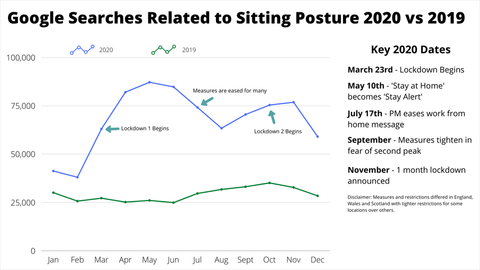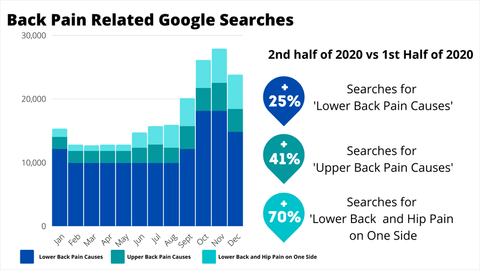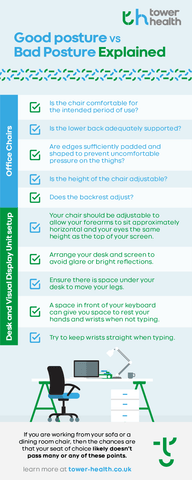

When the Coronavirus pandemic began and office workers throughout the UK were urged to work from home if they could, I don’t think any of us believed that so many months on that we would all still be working in our often makeshift home offices.
Did you put off ordering an office chair thinking that you’d be back in the office soon? Have you been working on a dining room chair at the table? Are you sitting on your sofa with your laptop on your lap? The chances are that you aren’t alone.
Initially we probably all assumed that we’d be at home for a couple of weeks while things went ‘back to normal’, which meant that we could probably put up with any makeshift home office space we had created for ourselves.
By the time April and May came we had perhaps started to take things a little more seriously, as some of us will have started to suffer from a little back ache - so we hit Google:
Searches such as: Sitting Posture, Chair Posture, and Best Posture for Sitting at a Desk All Day all saw huge increases in 2020 vs the previous year.

Google searches peaked in April, May and June with 70% more people searching for guidance on sitting posture each month than the year before. Coincidentally this spike coincided with a spike in searches for new office chairs and computer chairs, perhaps our temporary work from home solutions simply were not cutting it anymore.
Our body’s are quick to adapt to make themselves feel more comfortable, if you sit slouched for long periods of time your body will become comfortable in this state. Your body begins to work out how your muscles need to act in certain positions, and will start to tighten and lengthen muscles to suit this new position. This is how poor posture develops, and why it can then feel uncomfortable to stand with traditional good posture.
Despite our initial good intentions to seek out the right way to sit while working at home, the nation's posture worries continued.
During the second half of 2020 and a few months into working from home, Google searches started to turn to that of new aches and pains that we were all trying to self diagnose.

Compared with the first half of 2020, In the latter 6 months there was a 25% increase in searches for lower back pain causes, 41% increase in searches for upper back pain causes and 70% increase in searches for lower back and hip pain on one side, a common symptom of sciatica, which can flare up because of poor posture.
Poor posture can be one of the main causes of new back problems. Sitting for hours a day with rounded shoulders can cause a tightening of your chest muscles which start to pull your shoulders forward leading to that slouchy looking posture.
One key thing to look at to prevent your posture getting worse is your home office workstation. If you spend more than an hour at a time working in front of a computer, there are guidelines that your employer needs to follow in your office to ensure that your workstation passes a workstation assessment. When you’re at home it’s up to you to create the optimal working space.
Does your work from setup pass these tests?

How many of the rules and guidelines from the Government’s Health and Safety Executive does your home workspace pass?
Office Chairs
- Is the chair comfortable for the intended period of use?
- Is the lower back adequately supported?
- Are edges sufficiently padded and shaped to prevent uncomfortable pressure on the thighs?
- Is the height of the chair adjustable?
- Does the backrest adjust?
If you are working from your sofa or a dining room chair, then the chances are that your seat of choice likely doesn’t pass many or any of these points.
Desk and Visual Display Unit setup
- Your chair should be adjustable to allow your forearms to sit approximately horizontal and your eyes the same height as the top of your screen.
- Arrange your desk and screen to avoid glare or bright reflections
- Ensure there is space under your desk to move your legs
- A space in front of your keyboard can give you space to rest your hands and wrists when not typing
- Try to keep wrists straight when typing
One instant issue you’ll likely notice is that if you’re working from a laptop, it is impossible to work with your arms horizontal and your eyes in line with the top of your screen which either means that for your arms to be comfortable you’re likely looking down at your laptop, making it impossible to have good sitting posture. One remedy for this would be to plug a monitor into your laptop when you aren’t working on the move.
These are just some of the key boxes that need to be ticked for a healthy workspace, HSE actually has a 22 page document for seating at work, and a 6 page document for sitting in front of a VDU.
How does my workspace affect my posture?
When we think of bad posture, we often think of rounded shoulders or slouching, but there are a number of other ways that your posture could be affecting your day to day life.
Here are a few examples of issues caused by poor posture:
Rounded Shoulders / Hunched over
Slumping and slouching in your chair can cause your shoulders to roll forward and appear rounded, giving you that hunched over look that we all associate with poor posture. If your shoulders are rounded forward it means that the muscles between your shoulder blades have lengthened and become loose, while the muscles in your chest have tightened. Poor sitting posture means that your muscles become accustomed to being in this position, so the remedy is to strengthen these areas.
A good way to tell if you have rounded shoulders is to stand in front of a mirror and let your arms hang down relaxed. If you have good posture your thumbs will face forward, if you have rounded shoulders your knuckles may face forward.
How to fix rounded shoulders
Focussing on strengthening the muscle between your shoulder blades and properly stretching out your chest muscles, over time shoulder upper back muscles will pull your shoulders back into line.
Poking your chin forward
If you sit staring at your monitor with your chin poking forward, this can be a sign of poor sitting posture and that your screen is too low for your eye line.
How to stop poking your chin forward
Adjust your seat or screen so that the top of your monitor is on eye level. Regularly stretch out your neck by pretending that there is a string attached to the top of your head and pulling upward. This should lengthen the back of your neck while tucking your chin.
Pelvis tilted back causing your buttocks to stick out
If your standing posture is a duck like posture with your chest and buttocks sticking out, it’s likely there is a curve at the bottom of your back. Any standing or sitting position where your body is out of alignment will cause your body to depend on muscles in the incorrect way. This type of posture can sometimes be caused by excessive weight or pregnancy where your centre of gravity is altered. If you’re exaggerating puffing out your chest or pulling your shoulders down, it may be at the detriment of curving your lower back.
How to fix curved lower back
Strengthening your core and buttock muscles while stretching your hip flexors and thighs can help loosen the problem area and make a more natural stance more comfortable.
Pelvis tilted forward causing flat lower back
You may think that the opposite of an overly curved lower back is a flat lower back, but a flat lower back forces your pelvis to sit tilted forward, which can also cause you posture problems. There should be a natural curve to your lower back, without being over pronounced. This type of posture issue is usually a symptom of muscle imbalance and can mean that you struggle to stand for long periods of time.
Spending long periods sat down can contribute to a flat lower back, this can then make you lean your neck and shoulders forward which in turn causes that rounded shoulder look.
When it comes to muscle imbalance, you may find that one of your glutes is stronger than the other, or when you’re doing ab exercises that you’re tensing your hip flexors more than your core muscles, all this can throw off the balance of how you stand and create bad posture habits.
How to fix flat lower back / forward tilting pelvis
You need to address the muscle imbalance, which would involve strengthening where needed and stretching out tight muscles that are pulling your alignment off.
Strengthen your core muscles, your glute muscles, the muscles between your shoulder blades and make sure that you’re working on your back and neck extensions to help keep yourself stretched out.
How to Fix Bad Posture

For most muscle related posture issues, these can be fixed by simply stretching the relevant muscles that may have tightened and strengthening the muscles than have lengthened and weakened. There are a number of ways you can do this:
Posture Exercises
Thankfully we live in a world where information is freely available and you’ll find plenty of posture improvement routines on Youtube for free. Exercises range from small stretching habits you can get into at your desk, through to fill workouts that focus on the muscles that tend to cause poor posture.
Posture Support
Posture correctors are an increasingly popular alternative method to help rectify any posture issues. A posture corrector or posture brace as they are sometimes known are primarily designed to help solve the problem of rounded shoulders, which tends to be at the crux of many of our posture problems.
The brace is worn almost like a waistcoat and it will help to force your shoulders back and your shoulder blades together. Initially this may be uncomfortable, but that is simply because your muscles have adapted to your rounded posture. Spending a period of time wearing a posture corrector will help correct posture feel much more natural.
At Tower Health we stock a posture brace from Posture Medic. The way Posture Medic differs from some other brands of posture corrector is that it also doubles up as a tool for your posture related exercises to help you stretch the muscles that need to be stretched, as well as strengthen the muscles that need to be strengthened to hold your body in correct alignment.
This video shows a demonstration for how the Posture Medic brace can be used in your exercises:
